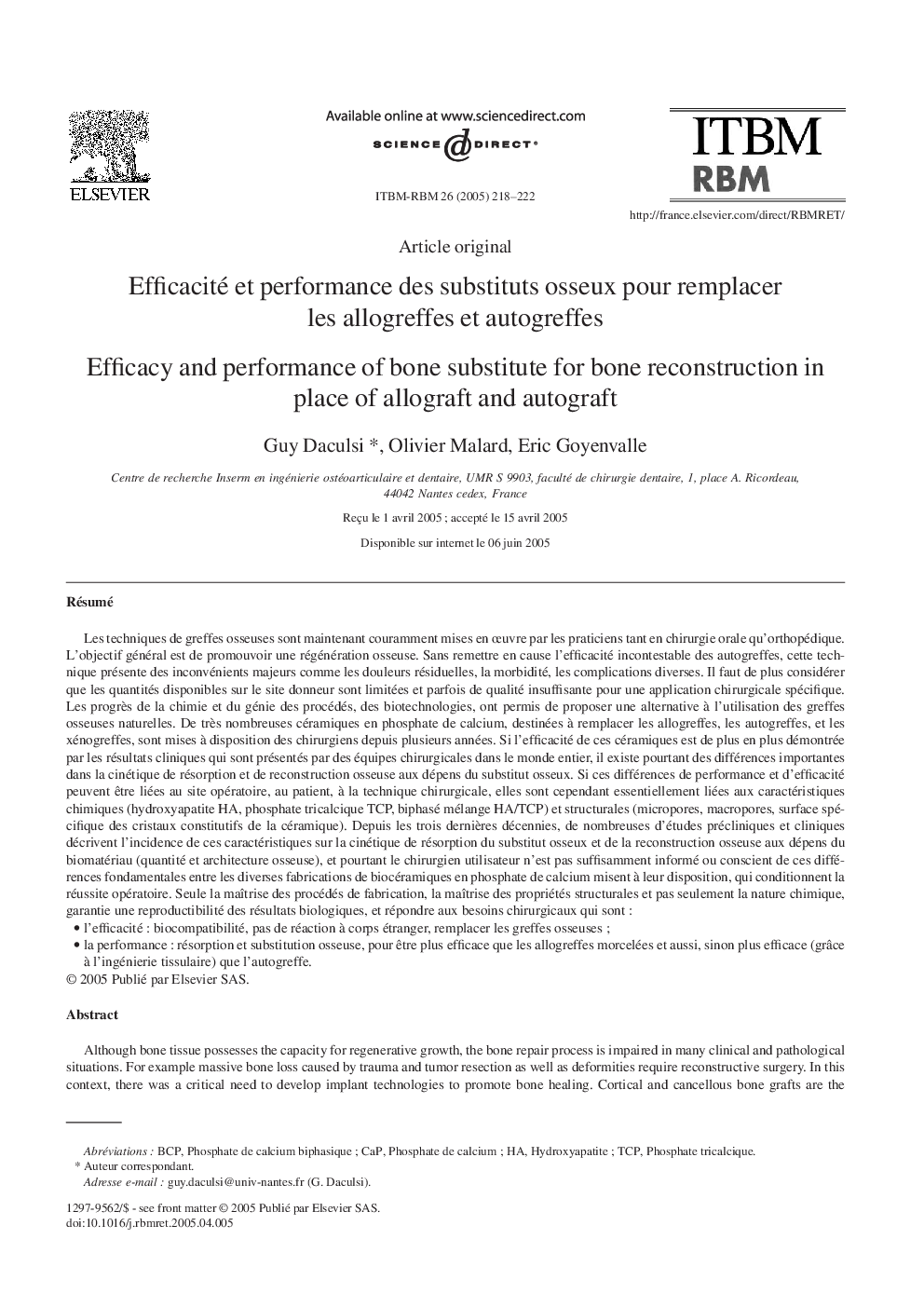| کد مقاله | کد نشریه | سال انتشار | مقاله انگلیسی | نسخه تمام متن |
|---|---|---|---|---|
| 10430659 | 910128 | 2005 | 5 صفحه PDF | دانلود رایگان |
عنوان انگلیسی مقاله ISI
Efficacité et performance des substituts osseux pour remplacer les allogreffes et autogreffes
دانلود مقاله + سفارش ترجمه
دانلود مقاله ISI انگلیسی
رایگان برای ایرانیان
کلمات کلیدی
موضوعات مرتبط
مهندسی و علوم پایه
سایر رشته های مهندسی
مهندسی پزشکی
پیش نمایش صفحه اول مقاله

چکیده انگلیسی
Although bone tissue possesses the capacity for regenerative growth, the bone repair process is impaired in many clinical and pathological situations. For example massive bone loss caused by trauma and tumor resection as well as deformities require reconstructive surgery. In this context, there was a critical need to develop implant technologies to promote bone healing. Cortical and cancellous bone grafts are the materials of choice for bone filling or reconstruction, but their clinical use involves some difficulties. Septic complications, viral transmission and unavailability of native bone have therefore led to the development of synthetic bone substitutes. Allograft bone, or tissue harvested from a cadaver, while more readily available, may carry with it the risk of disease transmission and is also difficult to shape [1-3]. A significant additional limitation of allograft bone is the delayed remodeling by the host. In the case of very large defects, the allograft may remain in the implant site throughout the patient's life, creating an area more prone to fracture or infection. The development of calcium phosphate ceramics and other related biomaterials for bone graft involved a better control of the process of biomaterials resorption and bone substitution. Synthetic bone graft materials available as alternatives to autogeneous bone for repair, substitution or augmentation, in particular synthetic biomaterials include, special glass ceramics described as bioactive glasses; calcium phosphates (calcium hydroxyapatite, HA; tricalcium phosphate, TCP; and biphasic calcium phosphate, BCP). These materials differ in composition and physical properties from each other and from bone; and must be take in consideration for more efficient bone ingrowth at the expense of the biomaterials and to adapt to new development of dedicated biomaterials. In the last decade synthetic calcium phosphate materials, principally calcium hydroxyapatite (HA) ceramics, was commercially used. However the concept of bioactivity (release of ions of biological interest) well described for glass ceramic was not particularly take in account for HA and other related biomaterials(ACP Amorphous Calcium Phosphate, CdA Calcium Phosphate deficient Apatite). HA until recently was considered to be non able to be resorbed. Calcium phosphate biomaterials differ in their solubility or extent of dissolution: ACP > > α-TCP > > β-TCP > CdA > > ACP. These ceramics are osteoconductive (act as a support for new bone formation requiring the presence of porosity) and able to be resorbed (degradable through chemical and cellular processes). They are also biocompatible (do not induce adverse local tissue reaction, immunogenicity or systematically toxicity); and more recently, some papers report osteoinductive properties associated to the chemical nature (biphasic Ca P) and the microstruture. Past decade, these bioceramics have been marketed and approved for use in humans as bone substitutes. Various presentations are currently used in orthopaedic and maxillo-facial surgery such as wedges, blocks or granules. Owing to their bone substitution properties, CaP ceramics have naturally been considered as a potential matrix for tissue engineering and the development of a bioactive drug delivery system (DDS) in bone sites. The paper presents the current knowledge on Calcium phosphate bioceramics, Bone tissue engineering and Calcium Phosphate Drug Delivery.
ناشر
Database: Elsevier - ScienceDirect (ساینس دایرکت)
Journal: ITBM-RBM - Volume 26, Issue 3, June 2005, Pages 218-222
Journal: ITBM-RBM - Volume 26, Issue 3, June 2005, Pages 218-222
نویسندگان
Guy Daculsi, Olivier Malard, Eric Goyenvalle,